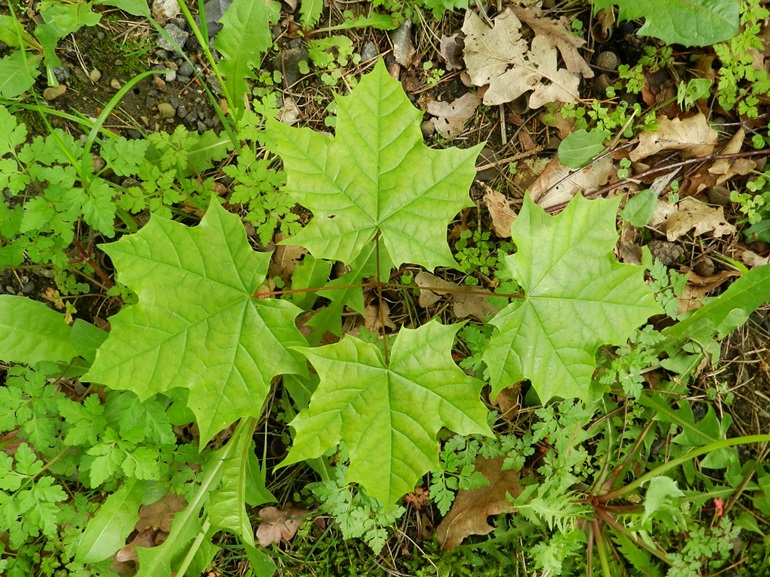Norway maple identification and control
Information about the weed of concern, Norway maple, also called harlequin maple. Norway maple is also known by its Latin name, Acer platanoides.
About this weed
Norway maple is designated as a weed of concern in King County, and is on the monitor list of the Washington State Noxious Weed Control Board. This means control is not required, but is recommended, and new plantings are discouraged.
Norway maple is known as Acer platanoides and it is in the soapberry family. There is a common cultivar called harlequin maple (Acer platanoides ‘Drummondii’) that can revert to Norway maple.

Why it's a problem
Norway maple has been planted on farms and in towns across the United States for its shade, hardiness, and adaptability. Unfortunately, it escapes plantings and joins native ecosystems. Once there, it displaces native, trees, shrubs, and understory plants. It creates a canopy of dense shade that prevents native seedlings from establishing. In urban settings its root system can also destroy pavement. It is a host for Sooty Bark Disease (Cryptostroma corticale) that can transfer to our native maple trees.
Sooty bark disease
Sooty bark disease is a pathogen that attacks the cambium (growth layer of the trunk) and bark. It can eventually kill the tree. With higher summer temperatures and increased frequency of drought due to climate change, the disease impacts will become more severe. It is also a danger to human health as the spores can cause extreme asthma and maple bark disease in workers who are regularly exposed. If working with infected trees wear personal protective gear like goggles and a respirator. The goal is to avoid getting the spores in your eyes and respiratory system.
For more information:
Plant description
Norway maple is a large deciduous (plant that loses its leaves annually) tree originally from Europe and west Asia. It can grow approximately 40 to 60 feet high.
They are tolerant of many different growing environments and well adapted to extreme soil types. They do prefer full sun but can be found in shady locations. They can be found anywhere from early to late succession forests, wetlands, yards, gardens, or in disturbed open areas and roadsides.
Their leaves are simple, green, and opposite (leaves connect to the stem in pairs). They are usually broader than they are high. They have 5 distinct lobes and are about 4 to 7 inches wide. Norway maples tend to leaf out earlier in the spring than other maples. If the petiole (leaf stalk) is cut a milky substance will ooze out.
The bark is greyish black and furrowed on mature trees. Younger trees have smooth bark. The flowers are yellow or greenish-yellow and approximately 8 mm in diameter. The flower clusters are present April to May.
During the summer the fruits mature into helicopter like blades. They reproduce by these winged seeds. Each tree creates many of these seeds and they are dispersed readily throughout the environment and establish quickly.








Be aware of look-alike plants
Norway maples may be confused with big leaf maple, Acer macrophyllum and our other native maples.
Ways to distinguish Norway maple from our local maples:
- The milky sap in the petiole
- Sharp points in the teeth on the leaf lobes
- Smooth bark on younger trees
When in doubt, take photos and share them with us or report them on iNaturalist.
What to do if you find it
Property owners in King County are not required to control Norway maple. King County is not generally tracking infestations. We can provide advice on how to control Norway maple, but there is generally no legal requirement to do so. The King County Noxious Weed Control Board encourages property owners to remove Norway maple where possible, and to avoid introducing it to new landscapes.
Consult an arborist if attempting to control a larger tree to ensure safety of surrounding people and property.
Control methods
We recommend using a combination of methods to control weeds. In areas with few weeds, it is important to act quickly before they become harder to control. Make a long-term plan as it often takes several years to get rid of most weeds. Start in the least infested areas first and then move into more heavily infested areas.
Manual control
Small trees may be pulled or dug up. This will be easier when the soil is moist. Carefully remove the entire plant including roots to avoid regrowth.
Mechanical control
Repeatedly cutting trees until they are no longer found can be effective in some situations.
Chemical control
Stay safe when using herbicide:
- Always read the label before use.
- Wear a long-sleeved shirt, long pants, shoes, and eye protection.
- Follow state and local regulations.
One option is to cut down the tree completely and paint concentrated herbicide on the freshly cut stump. This can be done on a tree of any size though it is most efficient for trees smaller than tree inches in diameter.
For larger trees an EZ-Ject Lance can be very effective when done properly.
If you cannot access an EZ-Ject Lance another option is to use a girdler or sharp tool to penetrate the bark around the circumference of the tree base and carefully spray/paint concentrated herbicide into the fresh cuts.
Systemic herbicides like glyphosate and triclopyr are often effective against trees. Glyphosate is nonselective and may damage or kill other plants it encounters. Triclopyr is a selective herbicide that only effects broadleaf plants. It can be used in grasslands or areas where desirable grasses are growing under or around targeted woody or broad-leaved invasive plants.
Disposal instructions
Before the seeds develop trees once pulled or cut may be left on site with roots exposed. If they do not have sooty bark disease, larger plants may be used as firewood (locally!), made into a brush pile, chipped, or burned.
Washington State Noxious Weed Control Board pamphlet on noxious weed disposal

 Translate
Translate